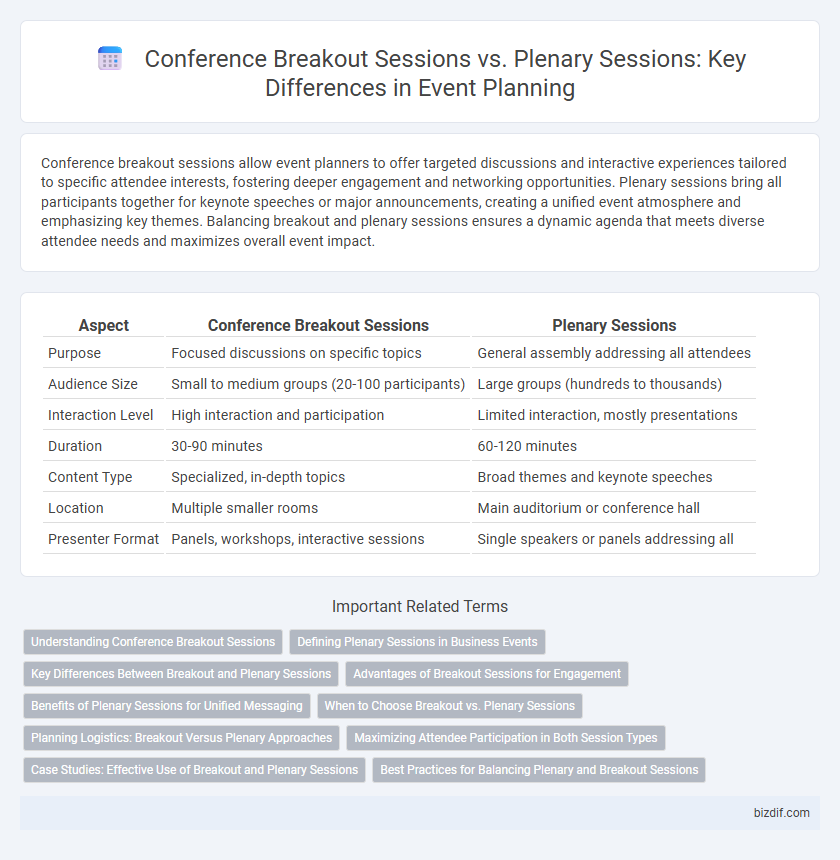Conference breakout sessions allow event planners to offer targeted discussions and interactive experiences tailored to specific attendee interests, fostering deeper engagement and networking opportunities. Plenary sessions bring all participants together for keynote speeches or major announcements, creating a unified event atmosphere and emphasizing key themes. Balancing breakout and plenary sessions ensures a dynamic agenda that meets diverse attendee needs and maximizes overall event impact.
Table of Comparison
| Aspect | Conference Breakout Sessions | Plenary Sessions |
|---|---|---|
| Purpose | Focused discussions on specific topics | General assembly addressing all attendees |
| Audience Size | Small to medium groups (20-100 participants) | Large groups (hundreds to thousands) |
| Interaction Level | High interaction and participation | Limited interaction, mostly presentations |
| Duration | 30-90 minutes | 60-120 minutes |
| Content Type | Specialized, in-depth topics | Broad themes and keynote speeches |
| Location | Multiple smaller rooms | Main auditorium or conference hall |
| Presenter Format | Panels, workshops, interactive sessions | Single speakers or panels addressing all |
Understanding Conference Breakout Sessions
Conference breakout sessions offer focused, smaller group discussions tailored to specific topics, enabling deeper engagement and interactive learning compared to plenary sessions. These sessions facilitate networking among participants with shared interests and allow for specialized content delivery that complements the general information shared in the main plenary. Understanding the strategic use of breakout sessions enhances attendee experience by providing diverse formats for knowledge exchange and skill development.
Defining Plenary Sessions in Business Events
Plenary sessions in business events gather all attendees in a single space, facilitating unified communication and key presentations from top executives or keynote speakers. These sessions are designed to set the tone of the event, deliver critical updates, and drive collective engagement. Unlike breakout sessions, plenary sessions emphasize broad relevance and strategic insights applicable to the entire audience.
Key Differences Between Breakout and Plenary Sessions
Conference breakout sessions offer smaller, focused group discussions tailored to specific topics, enabling interactive participation and in-depth exploration of subject matter. Plenary sessions gather all attendees in a single location for keynote speeches, major announcements, or broad presentations, fostering a unified conference experience. The key differences lie in group size, level of interaction, and session objectives, with breakouts emphasizing specialized engagement and plenaries prioritizing collective communication.
Advantages of Breakout Sessions for Engagement
Breakout sessions enhance attendee engagement by offering smaller, interactive group settings that promote active participation and personalized learning. These sessions allow for focused discussions and networking opportunities tailored to specific interests, increasing knowledge retention and collaboration. Unlike plenary sessions, breakout formats create a dynamic environment that encourages questions, diverse perspectives, and hands-on experiences.
Benefits of Plenary Sessions for Unified Messaging
Plenary sessions enhance unified messaging by bringing all attendees together in a single space, ensuring consistent communication of key themes and objectives across the entire conference. These sessions facilitate direct engagement with keynote speakers and critical content, promoting shared understanding and collective focus. This unified approach strengthens overall event impact and reinforces the conference's core messages effectively.
When to Choose Breakout vs. Plenary Sessions
Breakout sessions are ideal when targeting diverse audience interests, allowing smaller groups to engage in specialized discussions or hands-on activities tailored to their needs. Plenary sessions suit moments requiring unified messaging, such as keynote speeches or major announcements, ensuring all attendees receive the same core content. Event planners should choose breakout sessions to enhance participant involvement and personalization, while plenary sessions work best for delivering broad, impactful information to the entire conference audience.
Planning Logistics: Breakout Versus Plenary Approaches
Planning logistics for conference breakout sessions requires managing multiple smaller spaces simultaneously, coordinating varied topics, and ensuring timely transitions for attendees. Plenary sessions demand a single large venue with comprehensive audiovisual setups and streamlined crowd flow to accommodate all participants at once. Effective event planning balances resource allocation, space management, and scheduling intricacies between breakout and plenary formats to optimize attendee experience.
Maximizing Attendee Participation in Both Session Types
Conference breakout sessions offer targeted, interactive experiences that encourage active attendee engagement through smaller group discussions and specialized content. Plenary sessions deliver unified messaging and keynotes to all participants, fostering a shared sense of purpose and collective energy. Maximizing participation involves balancing focused breakout topics with dynamic plenary speakers, utilizing real-time polling and Q&A tools to maintain interaction across both formats.
Case Studies: Effective Use of Breakout and Plenary Sessions
Case studies reveal that effective use of breakout sessions enhances participant engagement through focused discussions and hands-on activities, promoting deeper understanding of complex topics. Plenary sessions, by contrast, unify attendees with keynote speakers and overarching themes, establishing common ground and setting the conference tone. Strategic scheduling of these sessions maximizes knowledge retention and networking opportunities, driving overall event success.
Best Practices for Balancing Plenary and Breakout Sessions
Effective event planning balances plenary and breakout sessions by aligning content with audience needs and engagement goals. Plenary sessions gather all attendees for keynotes and major announcements, maximizing shared experience and delivering core messages. Breakout sessions provide targeted, interactive learning opportunities, allowing smaller groups to dive into specialized topics, fostering networking and personalized engagement.
Conference breakout sessions vs Plenary sessions Infographic

 bizdif.com
bizdif.com